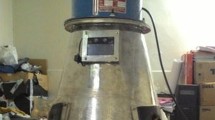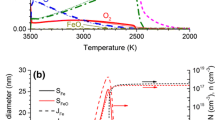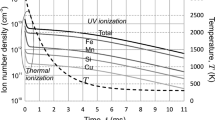Abstract
In order to clarify fume formation process in GMA welding, quantitative investigation based on understanding of interaction between the electrode, the arc, and the weld pool is indispensable. This study aims to clarify the fume formation process theoretically through numerical analysis. A fume formation model consisting of a homogeneous nucleation model, a heterogeneous condensation model, and a coagulation model was coupled with a GMA welding model. A series of processes such as evaporation of metal vapor from molten metal, transport of the metal vapor in the arc, fume formation from the metal vapor, and transport of the fume to the surrounding was investigated by employing this coupled simulation model. In this paper, the influence on the fume formation process of changing the shielding gas from Ar to CO2 and the associated change in arc characteristics, leading to different droplet formation and metal transfer phenomena, is discussed. As a result, it was clarified that the fume particles produced around the droplet were transported into the arc to be evaporated again and a large number of fine fume particles were produced in the downstream region of the plasma flow near the base metal in Ar GMA welding. In contrast, approximately 30% of all fume particles produced around the droplet were transported directly to the surrounding and the other particles were transported into the arc to be evaporated to produce fume particles in the downstream region in CO2 arc welding.












Similar content being viewed by others
References
Terasaki H, Tanaka M, Ushio M (2002) Effects of metal vapor on electron temperature in helium gas tungsten arcs. Metall Mater Trans A 33:1183–1188
Murphy AB (2010) The effects of metal vapour in arc welding. J Phys D Appl Phys 43:434001
Antonini JM (2003) Health effects of welding. Crit Rev Toxicol 33:61–103
Kobayashi M, Maki S, Hashimoto Y, Suga T (1980) Investigations on fume generating phenomena of shielded metal arc welding. J Japan Weld Soc 49:454–461
Jenkins NT, Eagar TW (2005) Chemical analysis of welding fume particles. Weld J 84:87s–93s
Bosworth MR, Deam RT (2000) Influence of GMAW droplet size on fume formation rate. J Phys D Appl Phys 33:2605–2610
Deam RT, Simpson SW, Haidar J (2000) A semi-empirical model of the fume formation from gas metal arc welding. J Phys D Appl Phys 33:1393–1402
Tashiro S, Zeniya T, Yamamoto K, Tanaka M, Nakata K, Murphy AB, Yamamoto E, Yamazaki K, Suzuki K (2010) Numerical analysis of fume formation mechanism in arc welding. J Phys D Appl Phys 43:434012
Tashiro S, Murphy AB, Matsui S, Tanaka M (2013) Numerical analysis of the influence of particle charging on the fume formation process in arc welding. J Phys D Appl Phys 46:224007
Boselli M, Colombo V, Ghedini E, Gherardi M, Sanibondi P (2013) Two-dimensional time-dependent modelling of fume formation in a pulsed gas metal arc welding process. J Phys D Appl Phys 46:224006
Sanibondi P (2015) Numerical investigation of the effects of iron oxidation reactions on the fume formation mechanism in arc welding. J Phys D Appl Phys 48:345202
Park H, Mudra M, Trautmann M, Murphy AB (2017) A coupled chemical kinetic and nucleation model of fume formation in metal-inert-gas/metal-active-gas welding. Plasma Chem Plasma Process 37:805–823
Tanaka M, Yamamoto K, Tashiro S, Nakata K, Yamamoto E, Yamazaki K, Suzuki K, Murphy AB, Lowke JJ (2010) Time-dependent calculations of molten pool formation and thermal plasma with metal vapour in gas tungsten arc welding. J Phys D Appl Phys 43:434009
Hertel M, Spille-Kohoff A, Fussel U, Schnick M (2013) Numerical simulation of droplet detachment in pulsed gas–metal arc welding including the influence of metal vapour. J Phys D Appl Phys 46:224003
Ogino Y, Hirata Y, Murphy AB (2016) Numerical simulation of GMAW process using Ar and an Ar–CO2 gas mixture. Weld World 60:345–353
Yamazaki K, Yamamoto E, Suzuki S, Koshiishi F, Miyazako S, Tashiro S, Tanaka M, Nakata K (2009) The surface temperature measurement of weld pool by infrared two-color pyrometry. Quarterly J Japan Welding Soc 27:34–40
Pratsinis SE (1988) Simultaneous nucleation, condensation, and coagulation in aerosol reactors. J Colloid Interface Sci 124:416–427
Phanse GM, Pratsinis SE (1989) Theory for Aerosol Generation in Laminar Flow Condensers. Aerosol Sci Technol 11:100–119
Aristizabal F, Munz RJ, Berk D (2006) Modeling of the production of ultra fine Aluminium particles in rapid quenching turbulent flow. Aerosol Sci 37:162–186
Tsujimura Y, Tanaka M (2012) Analysis of behaviour of arc plasma conditions in MIG welding with metal transfer - Visualization of Phenomena of Welding Arc by Imaging Spectroscopy Quarterly. J Japan Welding Soc 30:288–297
Tanaka M, Tashiro S, Satoh T, Murphy AB, Lowke JJ (2008) Influence of shielding gas composition on arc properties in TIG welding. Sci Technol Weld Join 13:225–231
Pires I, Quintino L, Miranda RM (2007) Analysis of the influence of shielding gas mixtures on the gas metal arc welding metal transfer modes and fume formation rate. Mater Des 28:1623–1631
Ioffe I, MacLean D, Perelman N, Stares I, Thornton M (1995) Fume formation rate at globular to spray mode transition during welding. J Phys D Appl Phys 28:2473–2477
Funding
This work was supported by JSPS KAKENHI Grant Number JP25420779.
Author information
Authors and Affiliations
Corresponding author
Additional information
Recommended for publication by Study Group 212 - The Physics of Welding
Rights and permissions
About this article
Cite this article
Tashiro, S., Murphy, A.B. & Tanaka, M. Numerical simulation of fume formation process in GMA welding. Weld World 62, 1331–1339 (2018). https://doi.org/10.1007/s40194-018-0656-9
Received:
Accepted:
Published:
Issue Date:
DOI: https://doi.org/10.1007/s40194-018-0656-9




